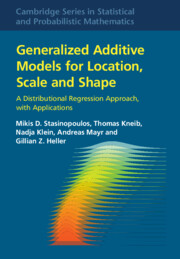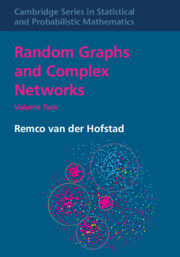Refine search
Actions for selected content:
2703 results in General statistics and probability
Contents
-
- Book:
- Generalized Additive Models for Location, Scale and Shape
- Published online:
- 22 February 2024
- Print publication:
- 29 February 2024, pp vii-xii
-
- Chapter
- Export citation
10 - Social Media Post Performance
- from Part III - Applications and Case Studies
-
- Book:
- Generalized Additive Models for Location, Scale and Shape
- Published online:
- 22 February 2024
- Print publication:
- 29 February 2024, pp 230-238
-
- Chapter
- Export citation
Acknowledgments
-
- Book:
- Generalized Additive Models for Location, Scale and Shape
- Published online:
- 22 February 2024
- Print publication:
- 29 February 2024, pp xvii-xvii
-
- Chapter
- Export citation
Preface
-
- Book:
- Generalized Additive Models for Location, Scale and Shape
- Published online:
- 22 February 2024
- Print publication:
- 29 February 2024, pp xiii-xvi
-
- Chapter
- Export citation
3 - Additive Model Terms
- from Part I - Introduction and Basics
-
- Book:
- Generalized Additive Models for Location, Scale and Shape
- Published online:
- 22 February 2024
- Print publication:
- 29 February 2024, pp 53-74
-
- Chapter
- Export citation
5 - Penalized Maximum Likelihood Inference
- from Part II - Statistical Inference in GAMLSS
-
- Book:
- Generalized Additive Models for Location, Scale and Shape
- Published online:
- 22 February 2024
- Print publication:
- 29 February 2024, pp 109-124
-
- Chapter
- Export citation
1 - Distributional Regression Models
- from Part I - Introduction and Basics
-
- Book:
- Generalized Additive Models for Location, Scale and Shape
- Published online:
- 22 February 2024
- Print publication:
- 29 February 2024, pp 3-29
-
- Chapter
-
- You have access
- Export citation
Part II - Statistical Inference in GAMLSS
-
- Book:
- Generalized Additive Models for Location, Scale and Shape
- Published online:
- 22 February 2024
- Print publication:
- 29 February 2024, pp 75-76
-
- Chapter
- Export citation
Index
-
- Book:
- Generalized Additive Models for Location, Scale and Shape
- Published online:
- 22 February 2024
- Print publication:
- 29 February 2024, pp 283-286
-
- Chapter
- Export citation
Part I - Introduction and Basics
-
- Book:
- Generalized Additive Models for Location, Scale and Shape
- Published online:
- 22 February 2024
- Print publication:
- 29 February 2024, pp 1-2
-
- Chapter
- Export citation
13 - Variable Selection for Gene Expression Data
- from Part III - Applications and Case Studies
-
- Book:
- Generalized Additive Models for Location, Scale and Shape
- Published online:
- 22 February 2024
- Print publication:
- 29 February 2024, pp 260-266
-
- Chapter
- Export citation
11 - Childhood Undernutrition in India
- from Part III - Applications and Case Studies
-
- Book:
- Generalized Additive Models for Location, Scale and Shape
- Published online:
- 22 February 2024
- Print publication:
- 29 February 2024, pp 239-252
-
- Chapter
- Export citation
References
-
- Book:
- Generalized Additive Models for Location, Scale and Shape
- Published online:
- 22 February 2024
- Print publication:
- 29 February 2024, pp 271-282
-
- Chapter
- Export citation
Part III - Applications and Case Studies
-
- Book:
- Generalized Additive Models for Location, Scale and Shape
- Published online:
- 22 February 2024
- Print publication:
- 29 February 2024, pp 195-196
-
- Chapter
- Export citation
Notation and Terminology
-
- Book:
- Generalized Additive Models for Location, Scale and Shape
- Published online:
- 22 February 2024
- Print publication:
- 29 February 2024, pp xviii-xx
-
- Chapter
- Export citation
Dedication
-
- Book:
- Generalized Additive Models for Location, Scale and Shape
- Published online:
- 22 February 2024
- Print publication:
- 29 February 2024, pp v-vi
-
- Chapter
- Export citation
4 - Inferential Methods for Distributional Regression
- from Part II - Statistical Inference in GAMLSS
-
- Book:
- Generalized Additive Models for Location, Scale and Shape
- Published online:
- 22 February 2024
- Print publication:
- 29 February 2024, pp 77-108
-
- Chapter
- Export citation

Generalized Additive Models for Location, Scale and Shape
- A Distributional Regression Approach, with Applications
-
- Published online:
- 22 February 2024
- Print publication:
- 29 February 2024

Random Graphs and Complex Networks
-
- Published online:
- 08 February 2024
- Print publication:
- 08 February 2024
Frontmatter
-
- Book:
- Random Graphs and Complex Networks
- Published online:
- 08 February 2024
- Print publication:
- 08 February 2024, pp i-iv
-
- Chapter
- Export citation
